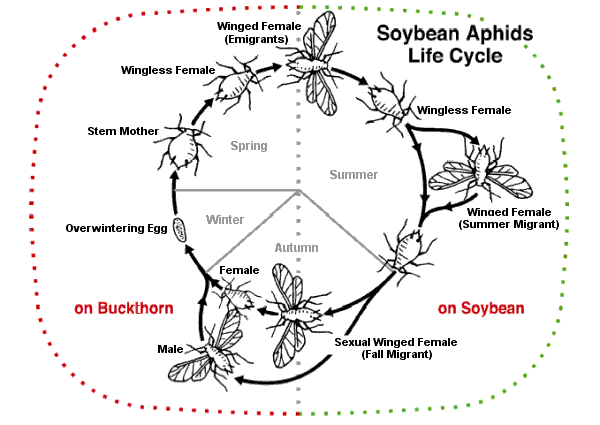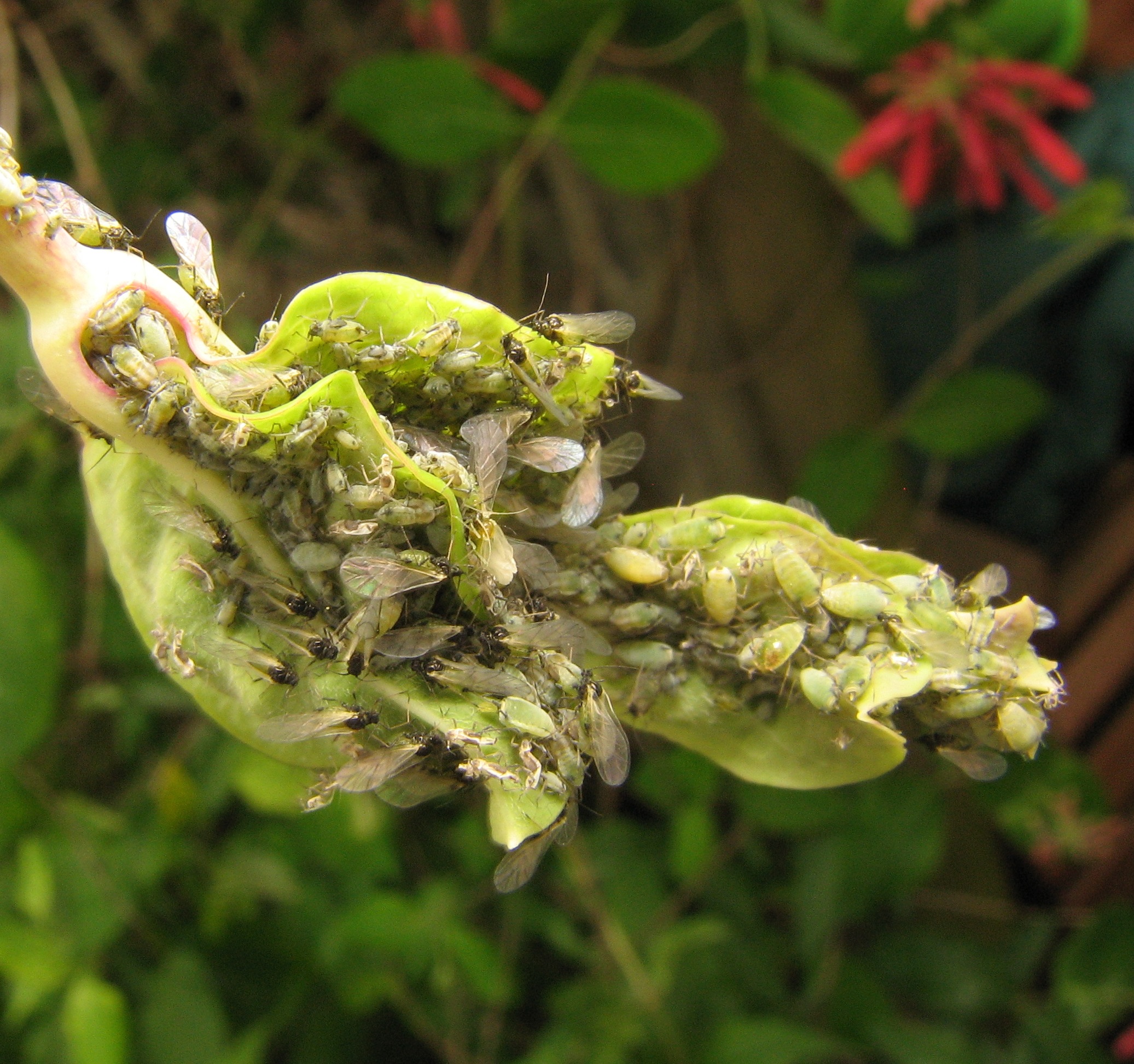|
Aphididae
The Aphididae are a very large insect family in the aphid superfamily ( Aphidoidea), of the order Hemiptera. These insects suck the sap from plant leaves. Several thousand species are placed in this family, many of which are considered plant/crop pests. They are the family of insects containing most plant virus vectors (around 200 known) with the green peach aphid ('' Myzus persicae'') being one of the most prevalent and indiscriminate carriers. Evolution Aphids originated in the late Cretaceous about (Mya), but the Aphidinae which comprises about half of the 4700 described species and genera of aphids alive today come from their most recent radiation which occurred in the late Tertiary less than 10 Mya.Von Dohlen CD, Moran NA (2000) Molecular data support a rapid radiation of aphids in the Cretaceous and multiple origins of host alternation. Biol J Linnean Soc 71: 689–717Von Dohlen CD, Rowe CA, Heie OE (2006) A test of morphological hypotheses for tribal and subtribal rela ... [...More Info...] [...Related Items...] OR: [Wikipedia] [Google] [Baidu] |
Aphid
Aphids are small sap-sucking insects in the Taxonomic rank, family Aphididae. Common names include greenfly and blackfly, although individuals within a species can vary widely in color. The group includes the fluffy white Eriosomatinae, woolly aphids. A typical life cycle involves flightless females giving Viviparity, live birth to female Nymph (biology), nymphs—who may also be already Pregnancy, pregnant, an adaptation scientists call telescoping generations—without the involvement of males. Developmental biology, Maturing rapidly, females breed profusely so that the number of these insects multiplies quickly. Alate, Winged females may develop later in the season, allowing the insects to colonize new plants. In Temperate climate, temperate regions, a phase of sexual reproduction occurs in the autumn, with the insects often overwintering as eggs. The life cycle of some species involves an alternation between two species of host plants, for example between an annual crop and ... [...More Info...] [...Related Items...] OR: [Wikipedia] [Google] [Baidu] |
Soybean Aphid
The soybean aphid (''Aphis glycines'') is an insect Pest (organism), pest of soybean (''Glycine max'') that is exotic species, exotic to North America. The soybean aphid is native to Asia. It has been described as a common pest (organism), pest of soybeans in China and as an occasional pest of soybeans in Indonesia, Japan, Korea, Malaysia, the Philippines, and Thailand. The soybean aphid was first documented in North America in Wisconsin in July 2000. Ragsdale ''et al.'' (2004) noted that the soybean aphid probably arrived in North America earlier than 2000, but remained undetected for a period of time. Venette and Ragsdale (2004) suggested that Japan probably served as the point of origin for the soybean aphid's North American invasion. By 2003, the soybean aphid had been documented in Delaware, Georgia (U.S. state), Georgia, Illinois, Indiana, Iowa, Kansas, Kentucky, Michigan, Minnesota, Mississippi, Missouri, Nebraska, New York (state), New York, North Dakota, Ohio, Pennsylvania ... [...More Info...] [...Related Items...] OR: [Wikipedia] [Google] [Baidu] |
Myzus Persicae
''Myzus persicae'', known as the green peach aphid, greenfly, or the peach-potato aphid, is a small green aphid belonging to the order Hemiptera. It is the most significant aphid pest of peach trees, causing decreased growth, shrivelling of the leaves and the death of various tissues. It also acts as a vector for the transport of plant viruses such as cucumber mosaic virus (CMV), potato virus Y (PVY) and tobacco etch virus (TEV). Potato virus Y and potato leafroll virus can be passed to members of the nightshade/potato family (Solanaceae), and various mosaic viruses to many other food crops. Originally described by Swiss entomologist Johann Heinrich Sulzer in 1776, its specific name is derived from the Latin genitive ''persicae,'' "of the peach". The syntype specimen of this species is located in the Illinois Natural History Survey Insect Collection. Life cycle Life cycle of the green peach aphid varies depending on temperature. A fully completed generation takes approximat ... [...More Info...] [...Related Items...] OR: [Wikipedia] [Google] [Baidu] |
Hyadaphis Winged Adults
''Hyadaphis'' is a genus of aphids in the family Aphididae The Aphididae are a very large insect family in the aphid superfamily ( Aphidoidea), of the order Hemiptera. These insects suck the sap from plant leaves. Several thousand species are placed in this family, many of which are considered plant/cr .... There are about 19 described species in ''Hyadaphis''. Species These 19 species belong to the genus ''Hyadaphis'': * '' Hyadaphis agabiformis'' (Nevsky, 1928) * '' Hyadaphis albus'' (Monzen, 1929) * '' Hyadaphis anethi'' Nieto Nafría, Pérez Hidalgo & P.A.Brown, 2016 * '' Hyadaphis bicincta'' Börner, 1942 * '' Hyadaphis bupleuri'' Börner, 1939 * '' Hyadaphis bupleuriphila'' Barjadze & Özdemir, 2018 * '' Hyadaphis coerulescens'' * '' Hyadaphis coriandri'' (Das, B.C., 1918) (coriander aphid) * '' Hyadaphis ferganica'' * '' Hyadaphis foeniculi'' (Passerini, 1860) (fenel aphid) * '' Hyadaphis galaganiae'' * '' Hyadaphis haplophylli'' Kadyrbekov, 2005 * '' Hyadaphis levant ... [...More Info...] [...Related Items...] OR: [Wikipedia] [Google] [Baidu] |
Cinara Strobi Eggs Closeup
''Cinara'', the conifer aphids or giant conifer aphids, is a genus of aphids in the family Aphididae. They are widespread in the Northern Hemisphere. These aphids specialize on conifers in the pine and cypress families.Jousselin, E., et al. (2013)Is ecological speciation a major trend in aphids? Insights from a molecular phylogeny of the conifer-feeding genus ''Cinara''.''Frontiers in Zoology'' 10 56. Some species are pests that attack cultivated Christmas trees. The parasitoid wasp species in the genus '' Pauesia'' are specific to the genus. '' Cinara cedri'' has been shown to host three symbionts: ''Buchnera aphidicola'', a secondary symbiont, and bacteria in the genus ''Wolbachia ''Wolbachia'' is a genus of gram-negative bacteria infecting many species of arthropods and filarial nematodes. The symbiotic relationship ranges from parasitism to obligate mutualism. It is one of the most common parasitic microbes of arthrop ...''. There are about 243 species in this genu ... [...More Info...] [...Related Items...] OR: [Wikipedia] [Google] [Baidu] |
Aiceoninae
''Aiceona''Takahashi R (1934) ''Stylops'' 3(3): 56. is the only genus in Aiceoninae: a monotypic subfamily of aphids Aphids are small sap-sucking insects in the Taxonomic rank, family Aphididae. Common names include greenfly and blackfly, although individuals within a species can vary widely in color. The group includes the fluffy white Eriosomatinae, woolly .... References {{Taxonbar, from=Q10403776, from2=Q18350539 Aphididae Sternorrhyncha genera Taxa named by Ryoichi Takahashi ... [...More Info...] [...Related Items...] OR: [Wikipedia] [Google] [Baidu] |
Insect
Insects (from Latin ') are Hexapoda, hexapod invertebrates of the class (biology), class Insecta. They are the largest group within the arthropod phylum. Insects have a chitinous exoskeleton, a three-part body (Insect morphology#Head, head, Thorax (insect anatomy), thorax and abdomen (insect anatomy), abdomen), three pairs of jointed Arthropod leg, legs, compound eyes, and a pair of antenna (biology), antennae. Insects are the most diverse group of animals, with more than a million described species; they represent more than half of all animal species. The insect nervous system consists of a insect brain, brain and a ventral nerve cord. Most insects reproduce Oviparous, by laying eggs. Insects Respiratory system of insects, breathe air through a system of Spiracle (arthropods), paired openings along their sides, connected to Trachea#Invertebrates, small tubes that take air directly to the tissues. The blood therefore does not carry oxygen; it is only partly contained in ves ... [...More Info...] [...Related Items...] OR: [Wikipedia] [Google] [Baidu] |
Cornicle
The cornicle (or siphuncule) is one of a pair of small upright backward-pointing tubes found on the dorsal side of the 5th or 6th abdominal segments of aphids. They are sometimes mistaken for cercus, cerci. They are no more than pores in some species. These abdominal tubes exude droplets of a quick-hardening defensive fluid''Aphid'', Henry G. Stroyan, McGraw-Hill Encyclopedia of Science and Technology, 8th Edition, 1997, containing triacylglycerols called ''cornicle wax''. There is some confusion in the literature about the function of the cornicle wax secretions. It was common at one time to suggest that the cornicles were the source of the Honeydew (secretion), honeydew, and this was even included in the ''Shorter Oxford English Dictionary'' and the 2008 edition of the World Book Encyclopedia. There also is documentation in the literature for cornicle wax luring predators in some cases. References Aphids Insect anatomy {{insect-anatomy-stub ... [...More Info...] [...Related Items...] OR: [Wikipedia] [Google] [Baidu] |
Alate
Alate (Latin ''ālātus'', from ''āla'' (“wing”)) is an adjective and noun used in entomology and botany to refer to something that has wings or winglike structures. In entomology In entomology, "alate" usually refers to the winged form of a social insect, especially ants or termites, though it can also be applied to aphids and some thrips. Alate females are referred to as gyne The gyne (, from Greek γυνή, "woman") is the primary reproductive female caste of social insects (especially ants, wasps, and bees of order Hymenoptera, as well as termites). Gynes are those destined to become queens, whereas female workers ...s, and are typically those destined to become queens. A " dealate" is an adult insect that shed or lost its wings ("dealation"). In botany In botany, "alate" refers to wing-like structures on some seeds that use wind dispersal. It is also used to describe flattened ridges which run longitudinally on stems. References External links * Insect ec ... [...More Info...] [...Related Items...] OR: [Wikipedia] [Google] [Baidu] |
Honeybee
A honey bee (also spelled honeybee) is a eusocial flying insect within the genus ''Apis'' of the bee clade, all native to mainland Afro-Eurasia. After bees spread naturally throughout Africa and Eurasia, humans became responsible for the current cosmopolitan distribution of honey bees, introducing multiple subspecies into South America (early 16th century), North America (early 17th century), and Australia (early 19th century). Honey bees are known for their construction of perennial colonial nests from wax, the large size of their colonies, and surplus production and storage of honey, distinguishing their hives as a prized foraging target of many animals, including honey badgers, bears and human hunter-gatherers. Only 8 surviving species of honey bees are recognized, with a total of 43 subspecies, though historically 7 to 11 species are recognized. Honey bees represent only a small fraction of the roughly 20,000 known species of bees. The best-known honey bee is the wes ... [...More Info...] [...Related Items...] OR: [Wikipedia] [Google] [Baidu] |
Honeydew (secretion)
Honeydew is a sugar-rich sticky liquid, secreted by aphids, some scale insects, and many other true bugs and some other insects as they feed on plant sap. When their mouthpart penetrates the phloem, the sugary, high-pressure liquid is forced out of the anus of the insects, allowing them to rapidly process the large volume of sap required to extract essential nutrients present at low concentrations. Honeydew is particularly common as a secretion in hemipteran insects and is often the basis for trophobiosis. Some caterpillars of Lycaenidae butterflies and some moths also produce honeydew. In addition to various sugars, honeydew contains small amounts of amino acids, other organic compounds, and inorganic Salt (chemistry), salts with its precise makeup affected by factors such as insect species, host plant species, and whether a symbiotic organism is present. Honeydew-producing insects, like cicadas, pierce phloem ducts to access the sugar rich sap; the excess fluid released by ci ... [...More Info...] [...Related Items...] OR: [Wikipedia] [Google] [Baidu] |






